Recently, the “undersea volcanic eruption in Tonga” has become a hot topic on the Internet.ZhangzidaoStocks suddenly went up and down.
Tonga volcano erupts, huge influx of scallopsZhangzidaoSafe haven?
Investors’ brains are wide open
At about 17:00 on January 17th, the official account of “Phoenix Weekly” Douyin “Phoenix WEEKLY” released a short video with the text saying “Due to the eruption of the Tonga volcano and the tsunami, a large number ofPacific Oceaninflux of scallopsZhangzidao, expects earnings to grow more than 100% this year. “

The reporter’s inquiry on the 18th found that the video had been deleted.
Earlier on the 17th, an investor asked Zhangzidao’s secretary of the board of directors at Shenzhen Stock Exchange Interactive Yi: “The volcanic eruption in the waters of Tonga has caused the seawater temperature in the nearby waters to rise.Pacific OceanThe possibility of scallops flooding into company waters for safety?If there is such a possibility, does the company have contingency plans to welcome the arrival of these scallops, or take measures to actively attract a part of the scallops?Pacific OceanHigh-quality scallop resources to the company’s waters, in order to boost the company’s economies of scale? “
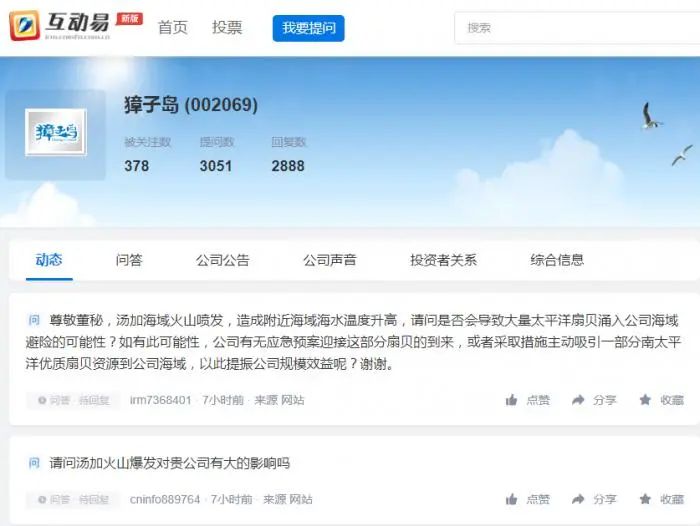
Image source: Shenzhen Stock Exchange Interactive Easy
As soon as the above news came out, netizens fried the pot in an instant. Some netizens said, “Tonga volcano erupted, scallops will definitely not be able to return to Zhangzi Island, because they are all cooked by magma”, “Scallops are sitting on intercontinental missiles”, and others Saying “Let’s talk and laugh, don’t take itperformancejoke”.
Zhangzidao’s stock price goes up and down, and the company urgently responded that it was seriously inaccurate
Expert: Scallops will not come
On the morning of January 18, Zhangzidao closed the board in a straight line in just 2 minutes, and the final share price closed at 4.26 yuan, with a market value of 3.029 billion yuan. The daily limit has more than 200,000 orders. The transaction amount was 320 million yuan, and the turnover rate exceeded 11%.
The latest data shows that Zhangzi Island hasshareholderThe number of 47369 households.
After the market on January 18, Zhangzidaoannouncement: The company is concerned about the recent media reports that “Tonga volcanic eruption and tsunami have caused Pacific scallops to flow into Zhangzi Island, and this year’s revenue will increase by 100%+” and related rumors. For relevant interviews and replies, the company reserves the right to protect its own rights and interests through legal channels. The company has explained it in the Shenzhen Stock Exchange Interactive Exchange.
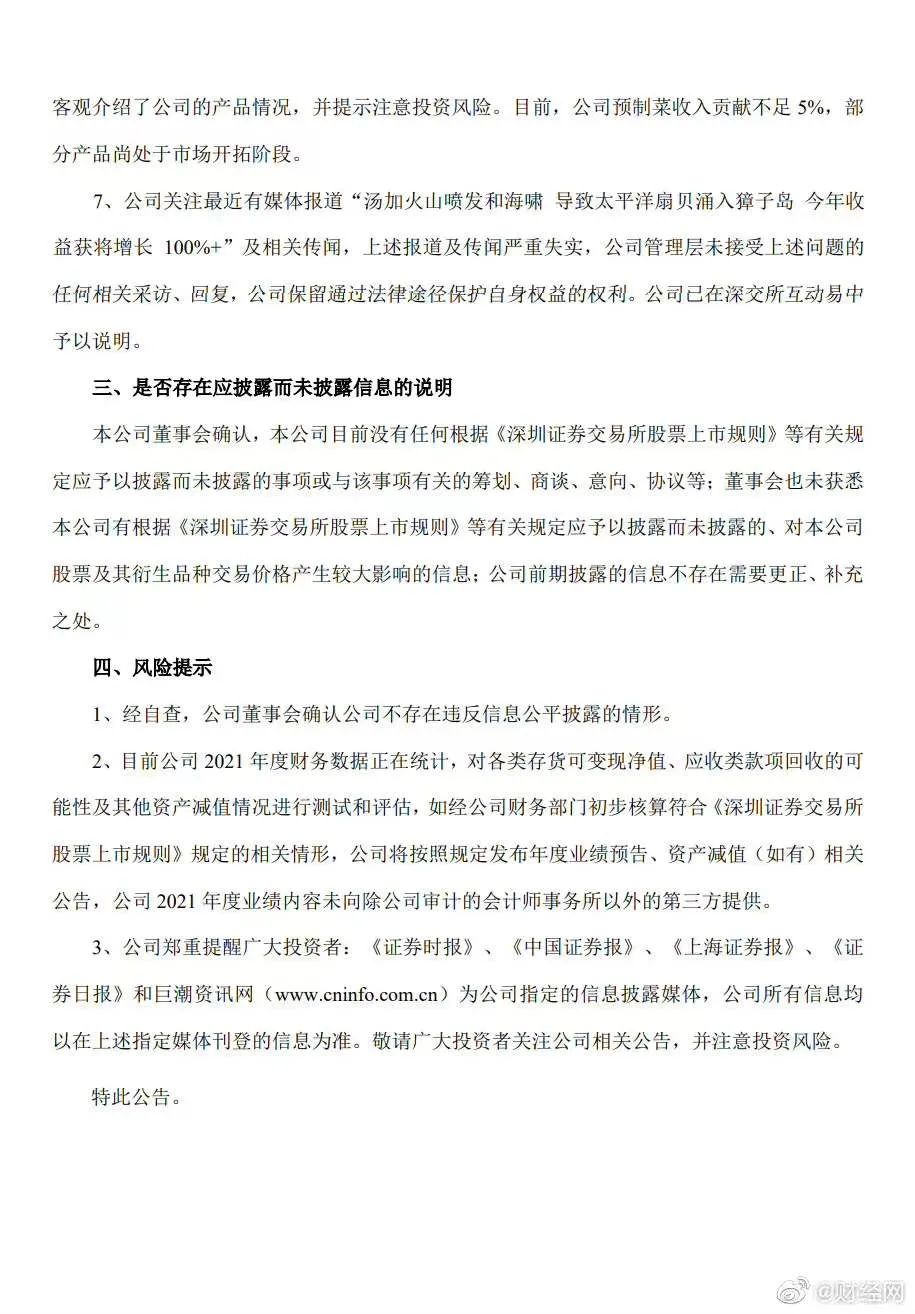
On January 18, Mu Yongtong, a professor at Ocean University of China, told the 21st Century Business Herald reporter, “The scallops living in the Pacific Ocean will not flood into Zhangzidao due to the eruption of the Tonga volcano, and the Ruozhangzidao company will indeed achieve 100% performance in 2022. growth (which may be possible), and online rumors will not be the reason for this speculative increase.”
According to the map distance measurement, Zhangzi Island is about 9,300 kilometers away from Tonga in a straight line. Considering the land barrier in the middle, the actual water distance may reach about 10,000 kilometers.
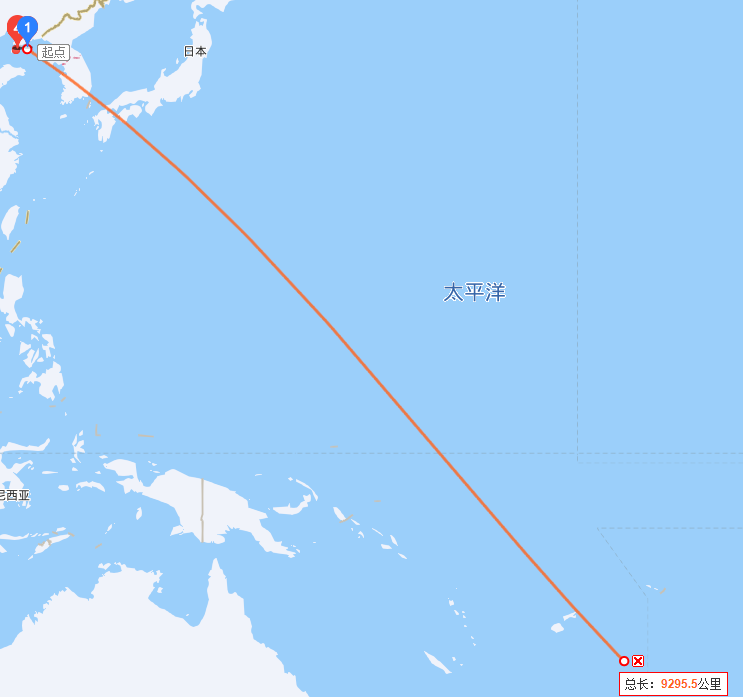
Standing on the prefabricated vegetable outlet?
ZhangzidaotimesAnswer: The income contribution of prepared vegetables is less than 5%
The reporter noticed that, benefiting from the approaching Spring Festival, the prefabricated vegetable sector has become a popular concept in A-shares recently, and stocks related to the subdivision sector have risen sharply recently.
On January 13, Zhangzidao said on the interactive platform that in recent years, the company has been committed to promoting the upgrade of ingredients to food, and has developed and launched “Zhangzidao Taste” marine food around the core marine resources of Zhangzidao. Pre-made vegetables such as garlic vermicelli, fish steak, fresh + scallop, black pepper salmon, dragon tendon and Buddha jumping over the wall have been launched one after another.
At that time, some investors joked that the scallops made into pre-made dishes can still run?

Zhangzidao issued an announcement on the 18th in response that the company responded to investment questions on the Shenzhen Stock Exchange Interactive Exchange on January 13th about whether the company has pre-made vegetables, objectively introduced the company’s products, and reminded to pay attention to investment risks.At present, the company’s prefabricated vegetables revenue contribution is less than 5%, and some products are still in the market development stage.
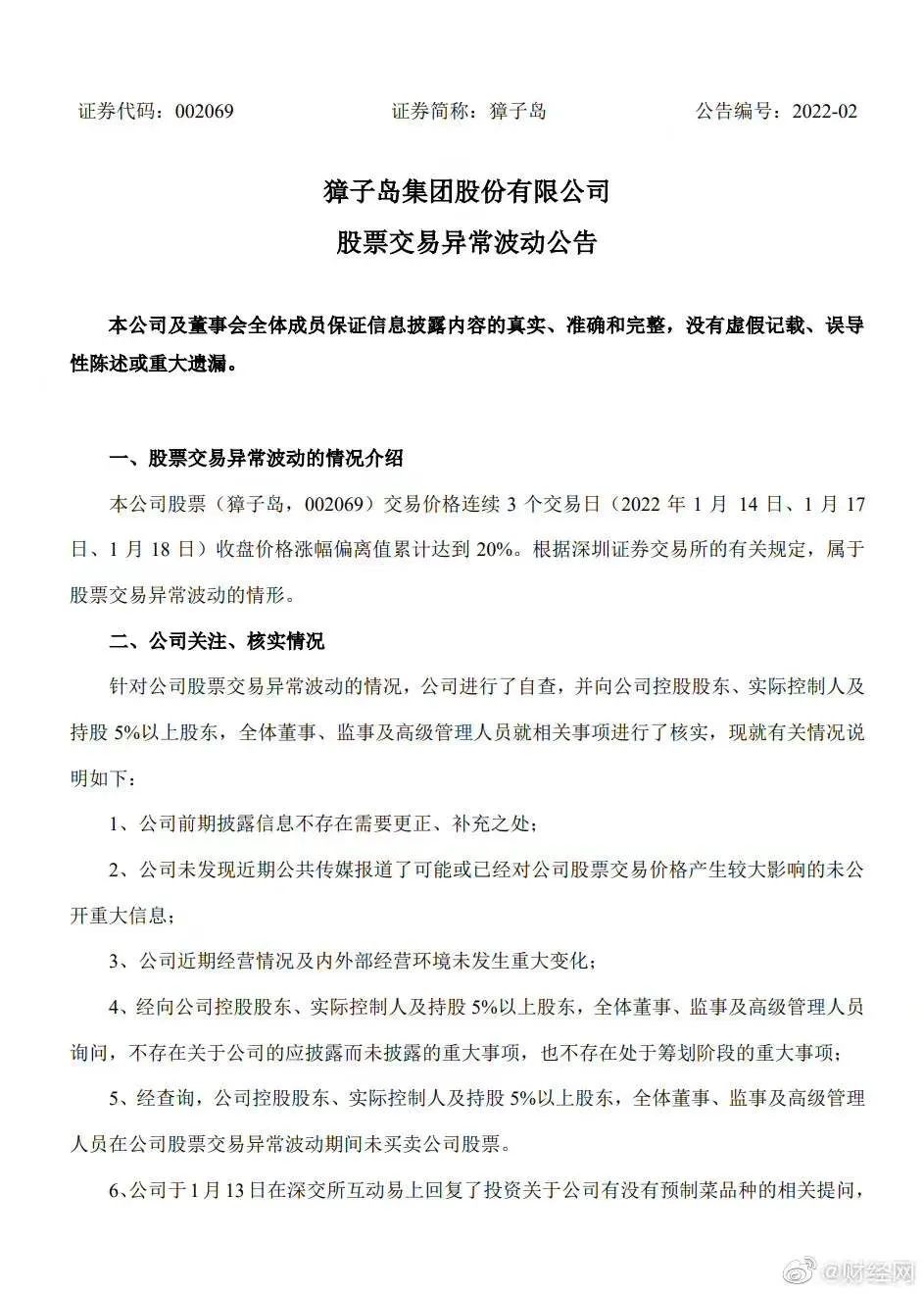
The China Securities Regulatory Commission used Beidou satellites to crack the mystery of scallops “fleeing”
According to the official website, Zhangzidao was founded in 1958. After years of development, Zhangzidao has now become a major business in the marine species industry, marine aquaculture, and marine food under the support of marine biotechnology, integrating cold chain logistics and marine leisure. It is a comprehensive marine enterprise integrating related diversified industries such as fishery equipment and fishery equipment.
In recent years, Zhangzidao has attracted attention from the outside world due to incidents such as scallops “running away” and financial fraud. It is worth mentioning that the China Securities Regulatory Commission also used the Beidou satellite navigation system to solve the mystery of Zhangzidao scallops’ “escape”.
On June 24, 2020, the China Securities Regulatory Commission issued an administrative penalty and market prohibition decision on Zhangzidao in accordance with the law, issued a warning to Zhangzidao, and imposed a fine of 600,000 yuan, and imposed a fine of 30,000 yuan to 300,000 yuan on 15 responsible persons. Fines, 5 years to lifetime market ban on 4 main responsible persons.
Since then, a series of lawsuits have followed. As of December 24, 2021, the cumulative number of frozen shares held by Zhangzidao’s controlling shareholders accounted for more than 80% of the company’s shares held by them. While coping with lawsuits, Zhangzidao has also continued to lose weight and “return blood”, trying to avoid the risk of delisting.
The 21st Century Business Herald reporter noticed that in the past five years, the company’s overall revenue has shown a downward trend.net profitAlso fluctuating.
The data shows that Zhangzidao achieved revenue of 3.206 billion yuan, 2.798 billion yuan, 2.729 billion yuan, and 1.927 billion yuan from 2017 to 2020; net profit was -447 million yuan, 34 million yuan, -385 million yuan, and 36 million yuan respectively. Yuan.
In the first three quarters of 2021, Zhangzidao achieved revenue of 1.568 billion yuan, a year-on-year increase of 6.77%; net profit of -11 million yuan, a year-on-year decrease of 123.19%.
On December 4, 2021, the board of directors of Zhangzidao reviewed and approved the “Proposal on the Sale of Branch Assets”, agreeing to sell the relevant assets of Zhuanghe Branch to Dalian Changying Ocean Ranch Co., Ltd. The total transaction price is 95 million Yuan. If nothing else, this will be the key to the turnaround of Zhangzidao’s annual report.
Actually, we don’t know much about volcanoes.
The author of the following is Songqiao Wei, assistant professor of geological sciences at Michigan State University. The main research directions are the geological structure, earthquakes, and volcanoes of the subduction zone around the Pacific Ocean. Since 2010, the submarine volcanoes and earthquakes in the Tonga subduction zone have been studied. The relevant research results have been published in academic journals such as Nature, Science Advances, EPSL, and JGR.
Currently chairs several U.S. national sciencefundThe project studies geophysical processes in Tonga, Alaska, and various subduction zones around the Pacific Ocean. It was originally planned to deploy a submarine seismic observation network in northern Tonga in 2020-2022, but unfortunately due to the impact of the epidemic and travel restrictions, the project has been postponed to 2023.
The volcanic eruption in early 2022 has brought Tonga to the attention of the world. Tonga is a tourist mecca, and apart from that, there are not many other opportunities to enter the global view.
But in fact, Tonga has always been a research hotspot in the field of geology and geophysics. When the Pacific plate subducts into the depths of the mantle along the Tonga Trench, the water-bearing minerals it carries will decompose under specific high temperature and pressure, and the released water will lower the melting point of the surrounding rocks to form magma, which rises to the surface and forms A volcanic island.
This is like putting a wooden board that has been soaked in sea water for hundreds of millions of years and roasting it on a fire deep in the earth, and the water in the board will evaporate. Together, these chains of volcanic islands and ocean trenches form a large and active system called the subduction zone, where most of the world‘s earthquakes and volcanic eruptions occur.
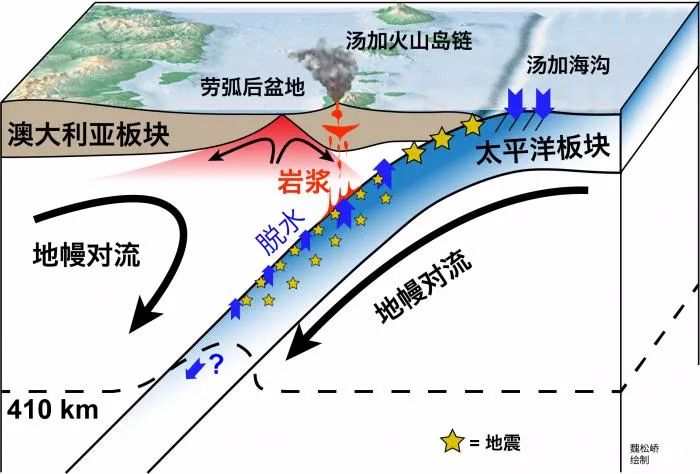
Schematic diagram of Tonga subduction zone
The protagonist of this volcanic eruption, Hunga Tonga-Hunga Ha’apai, is one of the most active volcanoes in the Tonga volcanic island chain in recent years, most of which are below sea level. Before 2014, there were only two small cusps above sea level, namely Hunga Tonga Island and Hunga Ha’apai Island. Deposits from an eruption in late 2014 and early 2015 connected the two islands.
Judging from the latest satellite images, the area above sea level has shrunk significantly, which means that there may be a large-scale collapse inside the crater, which may also be the direct cause of the tsunami. This is like the eruption of the Hawaiian volcano in 2018. When all the magma erupted, the volcano “felt the body was hollowed out”, the internal pressure became smaller, and the top collapsed naturally, waiting for the next cycle to accumulate power.
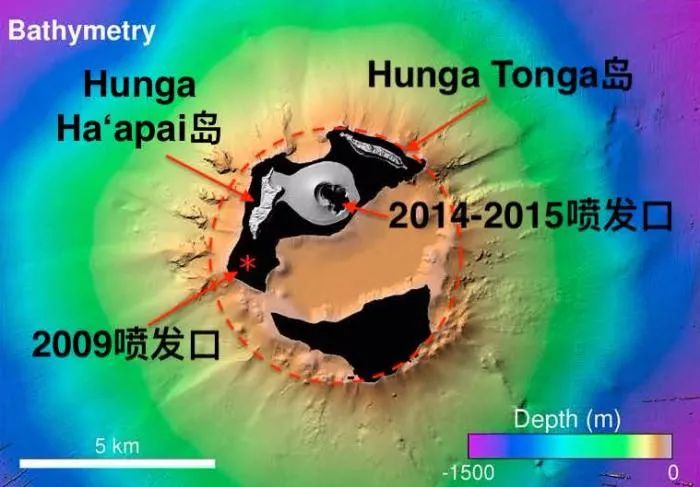
The undulating topography of the Hunga Tonga-Hunga Haapai volcano in 2016, with only the grey part above sea level. The red dotted line shows the entire crater extent, which may have been formed in a major eruption more than a thousand years ago. (Image credit: Garvin et al., 2018, GRL)
Tonga suddenly encountered such a large-scale volcanic eruption, which has aroused global attention for a while, what impact will the volcanic eruption bring, and will there be other volcanic eruptions?
Frankly speaking, for these volcanoes with lifespans ranging from 100,000 to 100,000 years, the quiet period of several years to several decades is only equivalent to a nap. Small magma eruptions and accompanying earthquakes occur from time to time, but Such a large scale is not uncommon.
This is speculation based on limited data and other studies of volcanoes. Due to the lack of up-to-date quantitative data, we do not know how much material was erupted and the new seafloor topography and crater shape after the eruption, so it is impossible to infer whether the volcano will immediately enter a quiet period.

Topography above sea level at Hunga Tonga-Hunga Haapai Volcano from December 10, 2021 to January 15, 2022. It can be seen that after the eruption on the 15th, only a small part is still above sea level. (Image credit: INGV vulcani)
After the Tonga volcano erupted, the question I received most was: “Did you not know anything about it beforehand?” Tonga has had active volcanoes for millions of years, and there have been many warnings before this largest eruption, But unfortunately, we don’t have enough observational data, so we didn’t foresee this outburst so large that it could affect the entire Pacific Ocean. Any forecast must answer three questions: where, when, and at scale.
Place:Unlike large earthquakes, which are elusive, the locations of major active volcanoes around the world are known. Human history is too short relative to the lifespan of volcanoes, and we are unlikely to encounter a completely new volcanic formation from scratch.
time:Large volcanic eruptions will be preceded by obvious abnormal seismic activity, surface deformation, etc. (this is different from some large earthquakes without any precursors). Therefore, if geophysical instruments can be deployed around the crater for 24-hour real-time monitoring, there is a high probability that these precursors will be captured, and then an early warning will be issued several days to several hours in advance. For example, many active volcanoes in Hawaii have such monitoring networks, and successfully warned of eruptions in 2018. However, for submarine volcanoes, 24-hour real-time monitoring is too difficult, and power supply and communication are all problems. The Axial Seamount off the U.S. west coast is one of the few continuously monitored submarine volcanoes, and scientists use hundreds of kilometers of cables to connect submarine instruments to land for power and data transmission. But limited by funding, the number of instruments is far less than the observation network in Hawaii. And Tonga has hundreds of submarine volcanoes, there is no manpower and material resources to build a huge monitoring network.
scale:How much magma can a volcano erupt at one time? Ideally, geophysical imaging is used to observe how much magma is underground, and how much magma is left after a volcanic eruption, and the rules can be grasped by measuring several times. This is equivalent to a small tumor growing in the human body. It is necessary to go to the hospital for CT scans regularly to accurately measure the size of the tumor. But this requires a more intensive monitoring network, and currently only a few volcanoes (such as Yellowstone National Park in the United States) can accurately know the total amount of magma under the volcano – this is only a static value. That is to say, so far, Huangshi has only performed high-precision CT once, and we do not know whether this “tumor” has grown or decreased over time. For submarine volcanoes, there is no place in the world where high-precision CT scans can be performed, let alone regular inspections. In addition, the intensity of a volcanic eruption depends not only on the total eruption volume, but also on the chemical composition of the erupting material and the eruption process. This adds a lot of uncertainty.
With infinite resources, we could install a monitoring real-time imaging network on a submarine volcano in Tonga, just like patients in an ICU. After accumulating dozens of hundreds of years of data in this way, we have an understanding of the temperament of this volcano, and then we may be able to accurately predict the next volcanic eruption.
But even so, compared to the millions of years of lifespan of volcanoes, there is a question mark on whether human observation data of several decades is sufficient. Therefore, everyone is currently taking a wait-and-see attitude towards submarine volcanoes all over the world-going to the scene after the eruption.
But geoscientists haven’t really lied down. Scientists in Tonga have been keeping a close eye on the volcano, and while without our ideal monitoring network, remote monitoring has caught some signs. As early as a volcanic eruption on January 14, local time, the local government issued a tsunami warning. By the time the biggest outbreak occurred on the 15th, many people were well prepared. Therefore, there were no large-scale casualties in the local area, and the real impact was on the infrastructure and other things that could not be moved. There is only so much we can do, the eruption is still going on, so safety is the priority right now.
Although the world is concerned about the secondary effects of volcanic eruptions, to judge the specific impact of volcanic eruptions on the climate and the earth’s environment, we don’t know much about volcanoes, and these are still questions that cannot be answered immediately. In the case of a volcanic eruption that continues, all we can do is avoid the current danger, and the rest can only wait for continued research.
Related reports
The stock price has a daily limit of 3 days and 2 days and is also stained with the concept of pre-made dishes Zhangzidao: Relevant reports and rumors are seriously untrue!
What do you think of “Zhangzidao’s scallops are back”?
(Article source: 21 Finance)
.
